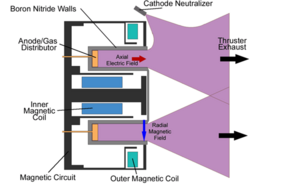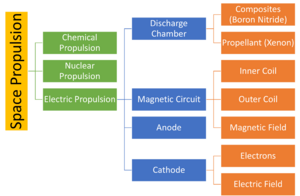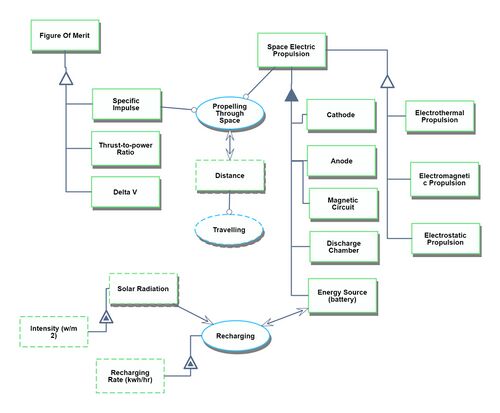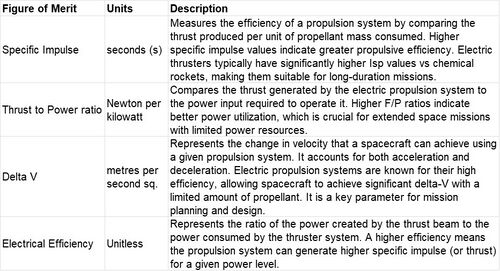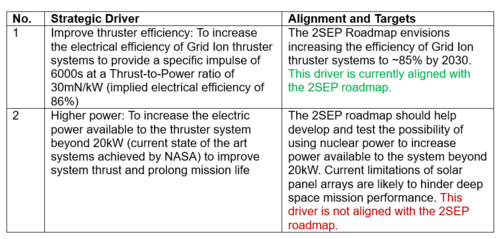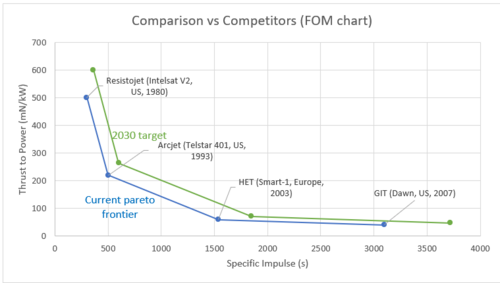Difference between revisions of "Space electric propulsion"
| Line 69: | Line 69: | ||
Patents: A summary of recent patent activity involving electric propulsion is summarized below. | Patents: A summary of recent patent activity involving electric propulsion is summarized below. | ||
# Methods and apparatus for performing propulsion operations using electric propulsion systems (US20200331638A1) – filed by Boeing Co: | |||
Markets: US | ::Markets: US | ||
Filed: 6/16/2020 | ::Filed: 6/16/2020 | ||
Granted: 7/25/2023 | ::Granted: 7/25/2023 | ||
This patent looks at a novel method and apparatus for performing propulsion using an electric propulsion system. An example launch vehicle includes a first space vehicle with a certain core structure and electric propulsion system, and a second space vehicle with a second core structure and a second electric propulsion system. The key insight is that the second core structure is releasably attached to the first space vehicle in a stacked configuration. | ::This patent looks at a novel method and apparatus for performing propulsion using an electric propulsion system. An example launch vehicle includes a first space vehicle with a certain core structure and electric propulsion system, and a second space vehicle with a second core structure and a second electric propulsion system. The key insight is that the second core structure is releasably attached to the first space vehicle in a stacked configuration. | ||
# Multiple space vehicle launch system (US9394065B2) – filed by Boeing Co: | |||
Markets: US, EP, CN | ::Markets: US, EP, CN | ||
Filed: 9/15/2014 | ::Filed: 9/15/2014 | ||
Granted: 7/19/2016 | ::Granted: 7/19/2016 | ||
Here, the authors have filed a patent for a vehicle launch system that includes a first space vehicle including a first core structure and a second space vehicle including a second core structure. The second core structure is oriented relative to the first space vehicle such that when placed within a fairing, a launch load is transmitted from the first core structure of the first space vehicle and is borne by the second core structure of the second space vehicle, thereby eliminating the need for a dual-launch structure or other reinforcing or support structures. The first space vehicle and the second space vehicle each include respective electric propulsion units. | ::Here, the authors have filed a patent for a vehicle launch system that includes a first space vehicle including a first core structure and a second space vehicle including a second core structure. The second core structure is oriented relative to the first space vehicle such that when placed within a fairing, a launch load is transmitted from the first core structure of the first space vehicle and is borne by the second core structure of the second space vehicle, thereby eliminating the need for a dual-launch structure or other reinforcing or support structures. The first space vehicle and the second space vehicle each include respective electric propulsion units. | ||
# Spacecraft propulsion system and method (RU2684968C2) – filed by Frederic Marchandiz: | |||
Markets: FR, EP, RU, JP, CN, WO | ::Markets: FR, EP, RU, JP, CN, WO | ||
Filed: 7/27/2015 | ::Filed: 7/27/2015 | ||
Granted: 4/16/2019 | ::Granted: 4/16/2019 | ||
This invention involves the use of a space propulsion system that comprises an electrostatic thruster and a resistojet thruster; a circuit to supply propellant fluid and a circuit for supplying electricity. The system also comprises a switch for connecting the electricity supply line to resistojet and electrostatic thruster. This method for propulsion in space includes a switching step to select the first driving mode in which the resistojet thruster is activated, or the second driving mode in which electrostatic thruster is activated. | |||
::This invention involves the use of a space propulsion system that comprises an electrostatic thruster and a resistojet thruster; a circuit to supply propellant fluid and a circuit for supplying electricity. The system also comprises a switch for connecting the electricity supply line to resistojet and electrostatic thruster. This method for propulsion in space includes a switching step to select the first driving mode in which the resistojet thruster is activated, or the second driving mode in which electrostatic thruster is activated. | |||
Revision as of 19:17, 2 November 2023
Electric Propulsion in Space
Roadmap Overview
Spacecraft electric propulsion uses electrostatic or electromagnetic fields to accelerate mass to high speed and thus generate thrust to modify the velocity of a spacecraft in orbit. This method leverages the charge/mass ratio of propellants, with relatively small potential differences potentially generating high exhaust velocities. This reduces the amount of reaction mass or propellant required, but increases the amount of specific power required compared to chemical rockets.
Electric thrusters typically use much less propellant than chemical rockets because they operate at a higher specific impulse than chemical rockets. Due to limited electric power the thrust is much weaker compared to chemical rockets, but electric propulsion can provide thrust for a longer time.
Design Structure Matrix (DSM) Allocation
Below we can see the DSM Allocation for the electric propulsion system. Sub components have been classified by tier and colour for ease of understanding (for instance, electrons and electric field are related to anode and cathode and thus highlighted in green). Cells shaded in yellow indicate that the corresponding components interact with each other during the operation of the propulsion system.
Roadmap Model using OPM
Figures of Merit
Relevant figures of merit can be seen in the table below.
Strategic Drivers
The key strategic drivers are electrical efficiency of the thruster system, and input power available to the thruster. These directly relate to increasing the product of specific impulse and thrust-to-power, which we know to be directly proportional to thruster efficiency. This is to say that increasing thrust efficiency pushes out the pareto frontier and will enable a more diverse range of space missions with longer lives. Additionally, increasing power available to the system will result in higher output thrust available.
Comparison with Competitors and FOMs
Given that thruster parameters vary widely by mission purpose and orbit, we consider 'competitors' to be rival space missions. For station keeping applications, we assume that our company is trying to improve on the Telstar 401 mission launched by the US in 1993. Similarly, for deep space missions, we would aim to build upon the progress achieved by the Dawn mission launched by NASA in 2007.
We look at the FOMs of Thrust-to-Power versus Specific Impulse to compare ourselves to our competitors. As can be seen, we have chosen to compare four electric propulsion technologies that were used to power four missions - Resistojet, Arcjet, Hall Effect, and Grid Ion. For each of these technologies, we have selected missions that have achieved results that are closest to the Pareto frontier (i.e. with the highest product of Thrust-to-Power and specific impulse). With regards to improvement in FOMs, we have assumed that our 2030 target is to see a 20% improvement for both parameters. This is purely to visualize how the Pareto front is likely to move with time - there are scenarios where we may want to trade off Thrust-to-Power for a higher specific impulse, and vice versa. This will likely be determined by the scope of mission, type of thruster chosen, and choice of propellant.
Morphological Tradespace
We can see the tradeoffs that each mission was forced to make to achieve its objectives. Clearly, as discussed above, the biggest tradeoff is with respect to Thrust-to-Power and Specific Impulse
Key Publications and Patents
Key Publications:
1. Igor Levchenko, Dan M. Goebel, Kateryna Bazaka; Electric propulsion of spacecraft. Physics Today 1 September 2022; 75 (9): 38–44. https://doi.org/10.1063/PT.3.5081
The publication covers a few key topics:
Improved stability and control: The authors explore how electric propulsion can enhance the stability and control of spacecraft – particularly for cubesats and satellite constellations that require thrust with precision. Hydrazine thrusters and cold gas systems do not have the level of specific impulse and control needed for these missions.
Barriers to adoption: The authors identify and discuss the challenges to the widespread adoption of electric propulsion in spacecraft – the lack of sufficient electric power on spacecraft, the ability to store sufficient energy, and thruster lifetime.
Electric thrusters in deep space: The publication explores applications of electric thrusters in deep space missions. The authors mention NASA’s Dawn mission, which was the first deep-space mission that used electric propulsion to reach and orbit two bodies in the asteroid belt—Vesta and Ceres. The spacecraft’s gridded ion thrusters used 400 kg of xenon to accomplish the mission. Chemical thrusters would have required more than 6 tons of additional fuel.
Ultimately, the authors present a comprehensive overview of the current state and future potential of electric propulsion technology for spacecraft.
2. Gabriel F. Benavides, Hani Kamhawi, Timothy R. Sarver-Verhey, Corey R. Rhodes, Matthew J. Baird, and Jonathan A. Mackey; High-propellant throughput Sub-kW electric propulsion system for Deep Space Science and exploration - NASA technical reports server (NTRS). NASA. https://ntrs.nasa.gov/citations/20220009248
This paper entails the development of high-propellant throughput sub-kW electric propulsion technologies to enable deep space science and exploration missions with high delta-v requirements, for small spacecraft.
The pathfinder model (PM) propulsion system consists of the H71M-PM HET, a breadboard 1-kW power processing unit (PPU), and a propellant flow control system. The propulsion system provides stable thrust generation over a wide range of operating conditions from 200 W to 1 kW, and 200 V to 400 V. The thruster has demonstrated a thrust as high as 68 mN at 300 V and 1 kW, and a specific impulse of 1850 s at 400 V and 1 kW.
Short duration wear tests indicate that a target thruster lifetime of 14 kh with 50% margin is feasible, though further verification of this result is needed.
Patents: A summary of recent patent activity involving electric propulsion is summarized below.
- Methods and apparatus for performing propulsion operations using electric propulsion systems (US20200331638A1) – filed by Boeing Co:
- Markets: US
- Filed: 6/16/2020
- Granted: 7/25/2023
- This patent looks at a novel method and apparatus for performing propulsion using an electric propulsion system. An example launch vehicle includes a first space vehicle with a certain core structure and electric propulsion system, and a second space vehicle with a second core structure and a second electric propulsion system. The key insight is that the second core structure is releasably attached to the first space vehicle in a stacked configuration.
- Multiple space vehicle launch system (US9394065B2) – filed by Boeing Co:
- Markets: US, EP, CN
- Filed: 9/15/2014
- Granted: 7/19/2016
- Here, the authors have filed a patent for a vehicle launch system that includes a first space vehicle including a first core structure and a second space vehicle including a second core structure. The second core structure is oriented relative to the first space vehicle such that when placed within a fairing, a launch load is transmitted from the first core structure of the first space vehicle and is borne by the second core structure of the second space vehicle, thereby eliminating the need for a dual-launch structure or other reinforcing or support structures. The first space vehicle and the second space vehicle each include respective electric propulsion units.
- Spacecraft propulsion system and method (RU2684968C2) – filed by Frederic Marchandiz:
- Markets: FR, EP, RU, JP, CN, WO
- Filed: 7/27/2015
- Granted: 4/16/2019
- This invention involves the use of a space propulsion system that comprises an electrostatic thruster and a resistojet thruster; a circuit to supply propellant fluid and a circuit for supplying electricity. The system also comprises a switch for connecting the electricity supply line to resistojet and electrostatic thruster. This method for propulsion in space includes a switching step to select the first driving mode in which the resistojet thruster is activated, or the second driving mode in which electrostatic thruster is activated.
